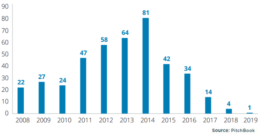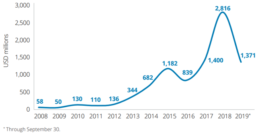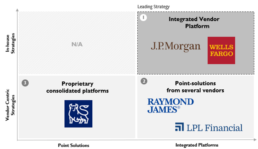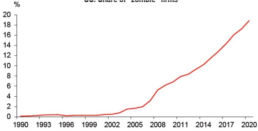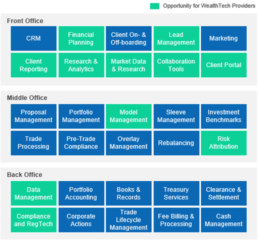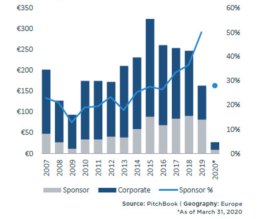TURBULENCE IN WEALTH TECH
The wealth tech sector has shown relative resilience through Covid-19 compared to other sectors. This mission-critical technology infrastructure provided to wealth managers is essential to their value proposition – both for near-term crisis management and longer-term value creation for the end-customer.
However, even before the pandemic induced recession hit the global economy, wealth tech was experiencing a significant slowdown. The number of new startups and capital raised has been falling for the last few years. As a result of market saturation, the industry recorded a sharp slump in new ventures in 2019 (see Exhibit 1).
Exhibit 1: Number of new wealth tech startups launched globally
The driving causes of the changing competitive dynamics have been:
- Pre-emptive strikes by wealth managers. For example, firms such as Vanguard, Fidelity, and Investec launched their own robo-advisors
- The best VC & PE investments have been made. Large funding rounds are concentrated around a few winners such as Betterment, Stash and Acorns
- Price compression among challengers. Wealth tech firms have struggled to find an equilibrium between growth and profitability amid high customer acquisition costs and limited per-customer revenue. For example, Wealthfront has a minimum deposit requirement of $250, 200 times less than the $50,000 required by Vanguard
Exhibit 2: Recent drop in wealth tech funding
NAVIGATING THE ROAD AHEAD
In the current recessionary environment firms will need to rapidly ensure business continuity and re-invent their value proposition to confront the industry-specific and macro-economic challenges ahead.
Challengers will need to adapt their business models and focus on strategic partnerships with incumbents. Rapid shifts to B2B business models will prevail, offering innovative solutions to incumbents with scale and infrastructure.
Incumbent wealth managers and wealth tech providers can modernize their value proposition via challenger partnerships or acquisitions. As an example, Franklin Templeton acquired the digital wealth platform AdvisorEngine in May 2020 to augment the digital servicing capabilities of its advisors. The transaction shows the continued market appetite for hybrid wealth advisory models, offering digital and human channels in one solution. In this document, we share our perspective on how wealth tech firms should navigate the upcoming market turmoil (see Exhibit 3).
Exhibit 3: Addressing the looming threats to wealth tech
WEATHERING THE STORM
Wall Street’s detachment from Main Street has never been wider.
The US financial markets rally extended well beyond expectations from the March 23rd, 2020 trough. The Nasdaq Composite reached the 10,000 mark for the first time in June, and the S&P showed gains for the year. Corporate bond issuance has been setting new records, as have inflows of investors’ funds into credit markets, despite very low yields. Meanwhile, the June 5th job report reported a 13.3% unemployment rate, the highest in the post WWII period.
These economic indicators signal a high degree of downside risk and continued slowdown. Such a slowdown could lead to significant wealth loss for both institutional and retail investors.
Ensuring stability and strengthening customer support
At times like this, wealth tech firms need to assess whether their tools have really passed the stress test during the first wave of Covid-19. The stability of the technology infrastructure made the headlines more than once. Robinhood, E-Trade and T-Ameritrade, among others, experienced multiple, prolonged outages in the high volatility market environment.
If a wide retracement in equities does occur, these incidents coupled with wealth loss may permanently damage a firm’s reputation. Alongside a reinforced tech infrastructure, firms should invest in a high touch customer support experience which would prevent social media storms during inevitable technology failures.
Re-structuring the operating model
Wealth tech providers should strive to preserve recurring revenues. Only firms with a strong P&L will be able to minimize impact on future earnings, which will naturally differ across geographies and business models. Critical business operations must be kept wisely resourced. Management should pursue structural cost reforms creating increased efficiency across the organization.
Capture large scale outsourcing from wealth managers. During the 10-year bull market run, cost programs were not in focus for wealth managers. Once they are done with the initial wave of cost cutting, we expect them to scale up outsourcing of technology, operations, and support functions (lock, stock and barrel) to Wealth tech platform providers. To further elaborate on outsourcing, over the past five years, wealth managers have taken one of three strategies for their technology platforms (see Exhibit 4):
- Proprietary consolidated platforms (in-house model): As an example, BAML built a single unified platform, MerrillOne, to upgrade business capabilities and lower costs. Nonetheless, other wealth managers are unlikely to pursue this route given the significant investment required. BAML’s path is viewed as a one-off by most market participants
- Consolidated platform with vendor support: In our perspective, this strategic play will become dominant. Wealth managers recognize the benefits of leveraging 3rd party vendors and are moving towards using a single end-to-end platform with either – One primary 3rd party vendor (e.g., UBS’s partnership with Broadridge, Wells Fargo’s partnership with Charles River) or Container strategy that may include multiple 3rd party vendors with significant integration in core functions (e.g., JPM’s “Connect” platform)
- Point-solutions from many vendors: A minority of sponsors (e.g., LPL, Raymond James) appear likely to continue using multiple point-solutions to meet the preferences of their advisor force and support legacy businesses.
Exhibit 4: Tech platform strategy of leading wealth managers
MOVING FROM DEFENSE TO OFFENSE
From a liquidity crisis to a banking crisis
The short-term risk of a second wave of Covid-19 and an end to the US equities hysteria would rapidly turn liquidity problems into solvency risk for the US companies (see Exhibit 5). If growth disappoints, the economy and markets will have to cope with a massive debt overhang. This scenario could result in further central bank action which would impose more distortions to markets with consequences on long-term growth potential.
The global debt pile has been growing in the financial system for decades. From the late 1980s, central banks conducted asymmetric monetary policy, supporting markets as they plunged yet failing to sell when they were prone to bubbles. Banking moral hazard was the natural consequence. Before Covid-19, the ratio of global debt to GDP hit an all-time high of over 322%, with total debt reaching close to $253tn. The implication, if the virus continues to spread, is that any fragilities in the financial system have the potential to trigger a new debt crisis.
Exhibit 5: Rise of “zombie” firms (debt servicing costs exceed profits)
A global debt crisis in the current macro-economic climate would result in a more painful downturn than the Great Financial Crisis of 2008-09 according to some estimates. Inflated private and public market valuations would be significantly written-down with systemic solvency implications. This scenario would cause broad lay-offs and a profound disruption of the American productive tissue which could take decades to repair.
Firms that front-loaded technology and digitalization investments over the past 10 years are likely to succeed and withstand a prolonged recession. On the other hand, any market player with significant tech debt will not be able to satisfy the high capital expenditures requirements during the crisis.
Digitizing the end-to-end value chain
Wealth tech firms must accelerate their efforts to empower financial advisors with a hybrid model, where client servicing is performed via digital channels and clients can receive, assess, and simulate the impact of investment proposals. Similar to other industries as consumer retail or tele-communications, wealth management clients must have the option of an entirely digital experience.
Wealth managers experimenting with these operating models still suffer from capability gaps (see Exhibit 6 for a view of the required functionalities). Internal adoption of digital capabilities has been low thus far, partly due to lack of innovative software solutions. The new paradigm is a shift from the “branch first” to the “digital first” philosophy for RMs and customer service representatives. As part of this, the digital and analytics infrastructure will be the differentiating component of the wealth tech value proposition.
Exhibit 6: Opportunities for Wealth Tech providers
Client centricity & customization
Personalize client services. As the end-customer demographic changes from baby boomers and gen X to millennials, the personalization of the client experience from on-boarding to periodic communications needs to be on-par with other industries (e.g., consumer, media, other Fintech verticals, etc.). Wealth tech firms can empower financial advisors with actionable data insights into their client base to make the end-to-end experience more personal. Personalized client interactions will be of particular importance during times of market turbulence.
As an example, market updates and notifications should be tailored to each client’s portfolio characteristics. Wealth managers still use static segmentation strategies on clusters of comparable clients leaving significant room for innovation. The data-powered approach must be extended to all aspects of a wealth manager value proposition. Data-driven customization will drive everything from client acquisition, to pricing and client retention with a clear ROI benefit.
RE-INVENTING THE BUSINESS MODEL
A new paradigm in American capitalism: Nasdaq > Dow.
Covid-19 has pushed the accelerator on an already digital economy, compressing years – perhaps decades – of digital adoption into a few quarters. Legacy customer service and client interaction models crumbled across industries, geographies, and customer segments. As an example, even in countries where cash was in widespread use as Italy digital-native experiences took over. Automation has been a key product principle for this shift in paradigm.
The Covid-19 recession will be characterized by a seismic shift in American capitalism: the Nasdaq overtaking the Dow. All firms will be technology firms powered by tech-savvy employees – signaling the transfer of wealth and power from baby boomers and gen X to millennials and gen Z participants. Paradoxically the global lockdowns were an unprecedented experiment to confirm a rapid transition to a fully digital world.
In this context, many legacy wealth management business models will not survive the downturn. As exhibited post Great Financial Crisis (GFC), carve-out transactions will be in vogue as large wealth managers outsource tech & ops functions to focus on their core service offering, and bolt-on acquisitions of point solutions (e.g., retirement planning SaaS) will also be in favor in light of the discounted valuations and need to raise capital divesting from the most attractive assets.
Transforming the value proposition
Wealth managers were slow in reacting to the GFC. While the wealth of high-net worth individuals was 85% higher in 2019 than in 2007, wealth managers’ profits in absolute terms are still far from pre-crisis levels – impacting recent investment in wealth technology.
GFC learnings need to spur a rapid and bold long-term value creation strategy built on data, analytics and digital capabilities enabling a personalized client experience for all segments. The nature of financial advisor will be morphed by the very technological solutions developed by wealth tech. The sector has once in a century opportunity to change identity democratizing access to managed wealth services.
Capitalizing on carve-outs and bolt-on acquisitions
The renewed pressure on wealth management margins and profitability coupled with heavily discounted valuations, will create opportunities for broad industry consolidation. Firms with strong balance sheets and funding will be able to capitalize on the new competitive landscape. Integration capabilities will be the other key to long-term success.
The crisis is already taking its toll on smaller firms, and in time these firms may seek new avenues for raising capital. At the same time, lower valuations amid market turmoil may present acquiring firms with an opportunity to increase scale, gain new capabilities, or enter new markets. As in the post GFC years, bolt-on acquisitions will be in vogue both in the medium and long-term. The potential rewards from bolt-on deals are numerous. These transactions come with relatively lower price tags than platform companies. Also, add-ons could help a platform company expand into new geographies, increase, or diversify product lines, and boost buying power. Looking at historical post crisis trends, the number of carve-out acquisitions is also expected to rise as businesses restructure (see Exhibit 7). However, around a fifth of carve-outs result in losses due to inefficiencies, therefore prudence is critical.
The market has seen a three-fold increase in the annual volume of spin-offs and carve-outs since 2016. Legal and regulatory barriers will be a key risk for carve-out success – especially in cross-border transactions.
Exhibit 7: Carve-outs and divestitures in Europe (EUR)
IN SUMMARY…
The Covid-19 crisis will likely reduce the AUM for the wealth-management industry over the short to medium term and force a seismic shift in the long-term value proposition. However, investor wealth levels are predicted to revert to historical growth rates by 2023-24 and wealth tech firms must compete aggressively to address the needs of a new customer base with a digital palate.
This is a wake-up call for the industry accelerating a generational transformation. Short-term resilience and a long-term vision will ensure success. Past crises show that first movers and bold decision makers rip disproportionate gains in the longer term.
